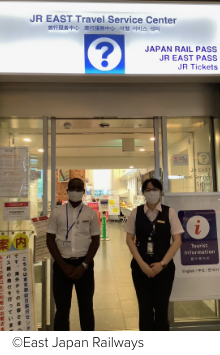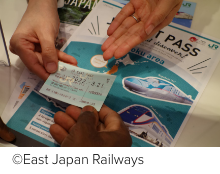
©East Japan Railways
The Japan Rail Pass has become a valuable tool for international visitors to Japan, allowing for a freer and more economical experience aboard Japan Railways’ many modes of transportation. Not merely limited to Japan’s famous bullet trains, this tourist pass also covers local lines, express trains, some JR buses and even a ferry. Though many are already familiar with the benefits and even uses of the pass, several things have changed during this unprecedented time and knowing what to expect when travel to Japan resumes will help for a smoother travel experience when using the Japan Rails Pass In the future. Complete information about the pass including scope of eligibility, purchase, pick up, and use can be found on the official Japan Rail Pass website.
Purchase of the Japan Rail Pass
One of perhaps the most significant updates to the process of becoming a Japan Rail Pass holder is the method of purchase which in previous years had to be done through a designated overseas sales office or, in some limited cases, at a JR ticketing office after arriving in Japan. Now, the JR Pass can be purchased directly and online through the dedicated Japan Rail Pass reservation website.
A few important things to note are that the business hours of the dedicated website are from 4:00 a.m. to 11:30 p.m. (Japan local time), you must have your passport number handy to complete purchase, and the credit card used for the purchase must match the name of the rail pass holder or, in the case of minors or groups of up to 6 eligible travelers, it must match the itinerary of the purchaser. Please also note that prices may differ slightly and purchase/reservations can only be made up to one month in advance. It is also possible to make seat reservations on bullet trains and limited express trains.
Appearance of the Japan Rail Pass
Travelers who have previously used the Japan Rail Pass may remember that it looked like a small booklet with a cover over the pass affixed inside. This paper cover will no longer be used so travelers should not be concerned to be presented with a smaller ticket as this will be their Japan Rail Pass for the entirety of its use. The pass will still be picked up by turning in your exchange order at any of the designated exchange and/or sales offices where you can also pick up your reserved seat tickets and/or make subsequent seat reservations. It is important to hold on to this ticket very carefully as the pass is still non-replaceable if lost.
JR Pass Use at Automatic Ticket Gates
Another important change to the use of the Japan Rail Pass is passing through automatic ticket gates. Where previously pass holders would wait in a designated line to have their Japan Rail Passes inspected by a gate agent, the pass can now be inserted into automatic ticket gates similar to individually purchased tickets to save you time.
When using an automatic ticket gate with your Japan Rail Pass, first make sure that it is not a gate indicated as “IC only” and do not try to go through the gate with only a seat reservation ticket. After inserting your JR Pass ticket into the slot, be sure not to forget to take your pass once it comes out of the other side of the ticket gate.
Regional Passes
Though regional versions of the Japan Rail Pass have been available for many years, it is always good to remember that if you will be traveling to and staying predominantly in a specific region of Japan, then a regional pass may be right for you. Regional passes such as the JR Tokyo Wide Pass, which covers popular destinations including Lake Kawaguchiko, Karuizawa, Nikko, and Izu, are available in shorter durations (3 days) and are perfect for doing a variety of day trips. You can find a list of as well as links to regional passes on the official Japan Rail Pass website.






















































